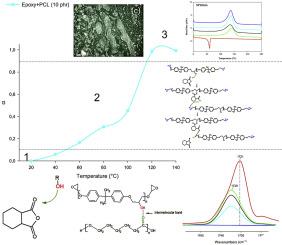当前位置:
X-MOL 学术
›
Polym. Test.
›
论文详情
Our official English website, www.x-mol.net, welcomes your
feedback! (Note: you will need to create a separate account there.)
Influence of PCL on the epoxy workability, insights from thermal and spectroscopic analyses
Polymer Testing ( IF 5.0 ) Pub Date : 2020-09-01 , DOI: 10.1016/j.polymertesting.2020.106679 Janetty Jany Pereira Barros , Ingridy Dayane dos Santos Silva , Nichollas Guimarães Jaques , Marcus Vinícius Lia Fook , Renate Maria Ramos Wellen
Polymer Testing ( IF 5.0 ) Pub Date : 2020-09-01 , DOI: 10.1016/j.polymertesting.2020.106679 Janetty Jany Pereira Barros , Ingridy Dayane dos Santos Silva , Nichollas Guimarães Jaques , Marcus Vinícius Lia Fook , Renate Maria Ramos Wellen

|
Abstract Epoxy compound based on diglycidyl ether of bisphenol A (DGEBA), methyl tetrahydrophthalic anhydride (MTHPA) as hardener and 2,4,6-tris (dimethylaminomethyl) phenol (DEH 35) as catalyzer, at 100/87/5 as fixed concentration was successfully processed. Aiming workable thermoset, thermoplastic Polycaprolactone (PCL) was added at 10, 20 and 30 phr contents to the epoxy compound. Analyses of Fourier transform infrared spectroscopy (FTIR), differential scanning calorimetry (DSC) and optical microscopy (OM) were conducted in order to obtain evidences from chemical interactions, curing kinetics and phase separation. From FTIR spectra partially miscibility between Epoxy and PCL can be assumed, mainly due to the hydrogen bonding between PCL carbonyl and epoxy hydroxyl, whereas after reaching epoxy's solubility limit PCL segregates and it is suggested separated phases take place through spinodal decomposition (Kinloch et al., 1994) [1] and nucleation and growth (NG) mechanisms which depend on temperature and raw material concentrations, as illustrated in OM images. Curing kinetics followed through released heat during DSC scans, indicated decreased crosslinking density upon PCL addition, as also lower Tg related to neat epoxy. Overcoming epoxy brittle fracture, rough surface fracture images with toughening character were captured from epoxy/PCL. Evidences of workable epoxy/PCL compounds are provided and related results presented in this work offer reliable tools to determine the exact aimed degree of crosslinking widening processing window to desired application.
中文翻译:

PCL 对环氧树脂可加工性的影响,热分析和光谱分析的见解
摘要 基于双酚 A 的二缩水甘油醚 (DGEBA)、甲基四氢邻苯二甲酸酐 (MTHPA) 作为固化剂和 2,4,6-三(二甲氨基甲基)苯酚 (DEH 35) 作为催化剂的环氧化合物,固定浓度为 100/87/5已成功处理。将可加工的热固性、热塑性聚己内酯 (PCL) 以 10、20 和 30 phr 的含量添加到环氧化合物中。进行了傅里叶变换红外光谱 (FTIR)、差示扫描量热法 (DSC) 和光学显微镜 (OM) 的分析,以便从化学相互作用、固化动力学和相分离中获得证据。从 FTIR 光谱可以假设环氧树脂和 PCL 之间存在部分混溶性,主要是由于 PCL 羰基和环氧羟基之间的氢键,而在达到环氧树脂后 s 溶解度极限 PCL 分离,并且建议分离的相通过旋节线分解(Kinloch 等,1994)[1] 以及取决于温度和原材料浓度的成核和生长 (NG) 机制发生,如 OM 图像所示。在 DSC 扫描期间通过释放热量跟随固化动力学,表明添加 PCL 后交联密度降低,以及与纯环氧树脂相关的 Tg 降低。克服环氧树脂脆性断裂,从环氧树脂/PCL 捕获具有增韧特性的粗糙表面断裂图像。提供了可使用的环氧树脂/PCL 化合物的证据,并且在这项工作中提出的相关结果提供了可靠的工具来确定交联扩大加工窗口到所需应用的确切目标程度。1994) [1] 以及取决于温度和原材料浓度的成核和生长 (NG) 机制,如 OM 图像所示。在 DSC 扫描期间通过释放热量跟随固化动力学,表明添加 PCL 后交联密度降低,以及与纯环氧树脂相关的 Tg 降低。克服环氧树脂脆性断裂,从环氧树脂/PCL 捕获具有增韧特性的粗糙表面断裂图像。提供了可使用的环氧树脂/PCL 化合物的证据,并且在这项工作中提出的相关结果提供了可靠的工具来确定交联扩大加工窗口到所需应用的确切目标程度。1994) [1] 以及取决于温度和原材料浓度的成核和生长 (NG) 机制,如 OM 图像所示。在 DSC 扫描期间通过释放热量跟随固化动力学,表明添加 PCL 后交联密度降低,以及与纯环氧树脂相关的 Tg 降低。克服环氧树脂脆性断裂,从环氧树脂/PCL 捕获具有增韧特性的粗糙表面断裂图像。提供了可使用的环氧树脂/PCL 化合物的证据,并且在这项工作中提出的相关结果提供了可靠的工具来确定交联扩大加工窗口到所需应用的确切目标程度。表明加入 PCL 后交联密度降低,与纯环氧树脂相关的 Tg 也较低。克服环氧树脂脆性断裂,从环氧树脂/PCL 捕获具有增韧特性的粗糙表面断裂图像。提供了可使用的环氧树脂/PCL 化合物的证据,并且在这项工作中提出的相关结果提供了可靠的工具来确定交联扩大加工窗口到所需应用的确切目标程度。表明加入 PCL 后交联密度降低,与纯环氧树脂相关的 Tg 也较低。克服环氧树脂脆性断裂,从环氧树脂/PCL 捕获具有增韧特性的粗糙表面断裂图像。提供了可使用的环氧树脂/PCL 化合物的证据,并且在这项工作中提出的相关结果提供了可靠的工具来确定交联扩大加工窗口到所需应用的确切目标程度。
更新日期:2020-09-01
中文翻译:

PCL 对环氧树脂可加工性的影响,热分析和光谱分析的见解
摘要 基于双酚 A 的二缩水甘油醚 (DGEBA)、甲基四氢邻苯二甲酸酐 (MTHPA) 作为固化剂和 2,4,6-三(二甲氨基甲基)苯酚 (DEH 35) 作为催化剂的环氧化合物,固定浓度为 100/87/5已成功处理。将可加工的热固性、热塑性聚己内酯 (PCL) 以 10、20 和 30 phr 的含量添加到环氧化合物中。进行了傅里叶变换红外光谱 (FTIR)、差示扫描量热法 (DSC) 和光学显微镜 (OM) 的分析,以便从化学相互作用、固化动力学和相分离中获得证据。从 FTIR 光谱可以假设环氧树脂和 PCL 之间存在部分混溶性,主要是由于 PCL 羰基和环氧羟基之间的氢键,而在达到环氧树脂后 s 溶解度极限 PCL 分离,并且建议分离的相通过旋节线分解(Kinloch 等,1994)[1] 以及取决于温度和原材料浓度的成核和生长 (NG) 机制发生,如 OM 图像所示。在 DSC 扫描期间通过释放热量跟随固化动力学,表明添加 PCL 后交联密度降低,以及与纯环氧树脂相关的 Tg 降低。克服环氧树脂脆性断裂,从环氧树脂/PCL 捕获具有增韧特性的粗糙表面断裂图像。提供了可使用的环氧树脂/PCL 化合物的证据,并且在这项工作中提出的相关结果提供了可靠的工具来确定交联扩大加工窗口到所需应用的确切目标程度。1994) [1] 以及取决于温度和原材料浓度的成核和生长 (NG) 机制,如 OM 图像所示。在 DSC 扫描期间通过释放热量跟随固化动力学,表明添加 PCL 后交联密度降低,以及与纯环氧树脂相关的 Tg 降低。克服环氧树脂脆性断裂,从环氧树脂/PCL 捕获具有增韧特性的粗糙表面断裂图像。提供了可使用的环氧树脂/PCL 化合物的证据,并且在这项工作中提出的相关结果提供了可靠的工具来确定交联扩大加工窗口到所需应用的确切目标程度。1994) [1] 以及取决于温度和原材料浓度的成核和生长 (NG) 机制,如 OM 图像所示。在 DSC 扫描期间通过释放热量跟随固化动力学,表明添加 PCL 后交联密度降低,以及与纯环氧树脂相关的 Tg 降低。克服环氧树脂脆性断裂,从环氧树脂/PCL 捕获具有增韧特性的粗糙表面断裂图像。提供了可使用的环氧树脂/PCL 化合物的证据,并且在这项工作中提出的相关结果提供了可靠的工具来确定交联扩大加工窗口到所需应用的确切目标程度。表明加入 PCL 后交联密度降低,与纯环氧树脂相关的 Tg 也较低。克服环氧树脂脆性断裂,从环氧树脂/PCL 捕获具有增韧特性的粗糙表面断裂图像。提供了可使用的环氧树脂/PCL 化合物的证据,并且在这项工作中提出的相关结果提供了可靠的工具来确定交联扩大加工窗口到所需应用的确切目标程度。表明加入 PCL 后交联密度降低,与纯环氧树脂相关的 Tg 也较低。克服环氧树脂脆性断裂,从环氧树脂/PCL 捕获具有增韧特性的粗糙表面断裂图像。提供了可使用的环氧树脂/PCL 化合物的证据,并且在这项工作中提出的相关结果提供了可靠的工具来确定交联扩大加工窗口到所需应用的确切目标程度。











































 京公网安备 11010802027423号
京公网安备 11010802027423号